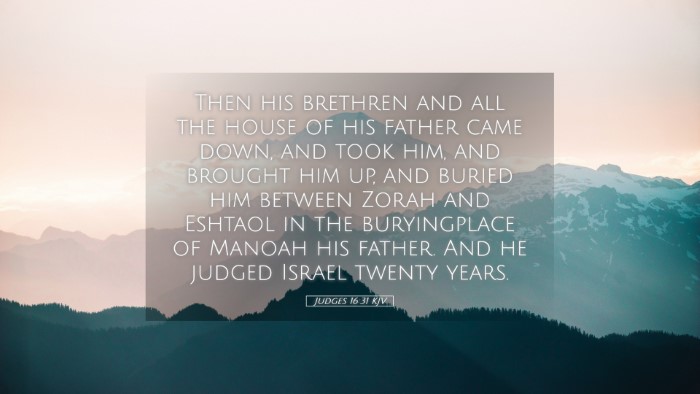Commentary on Judges 16:31
Verse Text: "Then his brothers and all the house of his father came down, and took him, and brought him up, and buried him between Zorah and Eshtaol in the burying place of Manoah his father. And he judged Israel twenty years."
Introduction
Judges 16:31 presents a poignant conclusion to the life and legacy of one of Israel's most notable judges, Samson. This verse encapsulates the aftermath of Samson's death—providing insight into familial relationships, the themes of redemption and loss, and the broader implications of leadership in Israel during the time of the judges.
Contextual Background
The Book of Judges details a period of Israel's history characterized by cycles of sin, oppression, repentance, and deliverance. Samson, introduced in Judges 13, was set apart from birth as a Nazirite and was empowered by the Spirit of God to confront Israel's enemies, primarily the Philistines.
Historical Context
-
Judgeship of Samson: Samson’s role was pivotal in the struggle against the Philistines. His exploits demonstrate the conflict between divine provision and human failure.
-
Cultural Implication: The backdrop of the narrative emphasizes the lawlessness and moral decay in Israel during this time, leading to the need for divinely appointed judges.
Analysis of Judges 16:31
1. The Role of Family in Samson's Death
The mention of “his brothers and all the house of his father” underscores the significance of familial ties. This act of retrieving Samson's body for burial indicates a reconciliation of sorts, as well as a recognition of familial duty despite the tumultuous nature of his life and the decisions he made that led to his downfall. Matthew Henry emphasizes that the family, despite their estrangement and disapproval of Samson's reckless decisions, embraces him in death, highlighting a spiritual dimension of mercy and forgiveness.
2. Burial Practices Reflecting Cultural Heritage
The act of burial between Zorah and Eshtaol, specifically in the tomb of Manoah, signifies a return to one's roots and a connection to heritage. Adam Clarke notes that this geographical reference signifies the extent of Manoah’s influence, and by burying Samson there, the family reaffirms identity and legacy. Burial rites in ancient Israel reflect respect for the dead and the hope of future resurrection, reflecting the covenant relationship with God.
3. The Longevity of Samson’s Judgeship
The verse concludes with the statement, "And he judged Israel twenty years." This highlights the significant yet tumultuous nature of Samson's service. Albert Barnes points out that despite the personal failings of Samson, his leadership had enduring impact. His tenure was marked not only by individual acts of strength but also by a providential role in God's overarching plan for Israel. The twenty years also represent a period of God's mercy, allowing these events to unfold despite the cycles of sin in the nation.
Theological Implications
1. Redemption and Sovereignty
Samson’s death can be seen as a climactic moment of redemption that continues the story of Israel’s deliverance. His final act—destroying the pillars of the Philistine temple—symbolizes the idea that God can bring good from human failures. This challenges readers to consider how God’s sovereignty works through imperfect vessels. Matthew Henry elaborates that even in Samson’s fall, God’s purposes prevail, which is a recurring theme throughout scripture.
2. The Nature of Leadership
This passage communicates critical lessons about leadership. Samson’s life serves as both a warning and a testament. The way his family honors him in death contrasts sharply with the chaos he often brought to life. Barnes reflects on the importance of integrity and reliance on God in leadership. The ultimate fate of leaders is often tied to their faithfulness or lack thereof.
3. The Hope for Restoration
The mention of burial signifies a resting place but also keeps open the theme of restoration. Clarke notes that God’s people should always hold onto the hope that individual failures may lead to national redemption. This brings a profound message to theologians and pastors who reflect on the transformative power of grace, even in scenarios marked by disobedience.
Conclusion
Judges 16:31 provides a compelling reflection on the complexities of human experience in relation to divine purpose. It challenges scholars and pastors alike to consider how life, death, and legacy interact within the scope of God's redemptive narrative. The life of Samson, filled with triumphs and pitfalls, serves as a microcosm of Israel's story and a lens through which we can explore themes of leadership, redemption, and the sovereignty of God. Each element in this passage encourages deeper theological reflection as well as practical application in ministerial contexts today.


